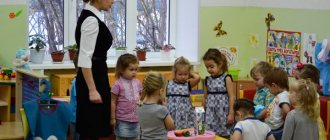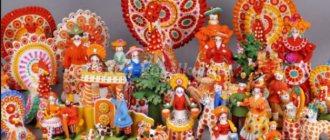Summary of a lesson in the middle group using sand therapy
Summary of a lesson with children of the middle group using sand therapy “Journey by the Sea”
Author: Svetlana Vasilievna Akhankova Teacher-psychologist I/Garden “Bolashak” Kazakhstan, Petropavlovsk
Summary of a lesson with children of the middle group using sand therapy “Journey by the Sea”
Purpose : relieving psycho-emotional stress through sand therapy. Objectives: Development of imagination, thinking, attention.
Development of general and fine motor skills. Teaching children relaxation and relieving muscle tension. Consolidation of knowledge on maritime topics. Materials and equipment: a box of sand, a tape recorder, an audio recording - the sound of the sea, a shell with a note, a plastic fish, cotton swabs according to the number of children, gouache, water, candles, pictures of the outline of fish. Progress of the lesson
Psychologist: Guys, today I found this shell on the windowsill, and inside it there was a note. Let me read it to you (reads). Who do you think could send it to us? (Children's answers). That's right, the Octopus sent us this letter, he asks us to help find a goldfish. What other sea inhabitants do you know? (children's answers). Are you ready to help the Octopus? (Children's answer). Then I suggest you go in search of a goldfish. Guys, what kind of transport can we use to travel? (Children's answers). What dangers can we face? (Children's answers). So let's put on our magic diving suit, strap an oxygen tank on our back, take a deep breath and hit the road. Everyone, one after another, through obstacles (massage paths, hoops, etc.) to the music, reaches the box with sand and discovers a photograph of a goldfish. Guys, let's remember what parts a fish consists of? (head, tail, fins, scales, etc.) Correct. The sea inhabitants left us a hint. You need to assemble a picture from these parts (assemble cut-out pictures of a goldfish). But in order for us to continue our journey, we need to stretch our hands. Psycho-gymnastics “Fishes” (performed to music) Fishes frolic merrily in clean, warm water. Either they will shrink, they will unclench, or they will bury themselves in the sand. The fishes, the fishes went down, The fishes, the fishes all went down. They all closed their eyes and buried their tails. The fins are relaxed and directed to the sides. We all calm down, Quietly relax. Oh, guys, look what a beautiful sand we have. (Music). Let's get closer. Place your palms on the sand, feel how it is - cold or warm, wet or dry. (Children's answers). Let's bury our hands in the sand, pour them from one hand to the other. Squeeze the sand into a fist and carefully pour it out. Guys, it seems to me that our fish is hiding somewhere here, let's look for it. (Under the sand there are sheets with the outline of a fish). Oh, and our fish was left completely without scales and lost all its magical power. Let's decorate it so that it comes to life. The fish has magical multi-colored scales. We take cotton swabs, the paint we like and paint the fish. Well done, you all completed the task, and our fish came to life (shows the fish). Now she can fulfill your every wish. Let's close our eyes and make a wish. We close our eyes and count to five. (The psychologist lights candles as they go around). We count to five and open our eyes. Look how beautiful it is, it gave us the underwater kingdom because we saved the goldfish. Place your palms and feel the warmth. Remember your desires. They will certainly come true. It's time to say goodbye to the goldfish and all the inhabitants of the underwater kingdom. Let's tell them together - Goodbye! And now it's time to go back to kindergarten. Let's hold hands, blow on the candles together and close our eyes. One, two, three, get back into the group. Here we are again in kindergarten. Did you enjoy the trip? What did you like most? What do you remember? Well done. I also really enjoyed traveling with you. We will definitely go on some kind of trip again.
We recommend watching:
Synopsis of an integrated GCD in kindergarten in the middle group Synopsis of a game lesson in the middle group Synopsis of GCD in the middle group on the theme “New Year” GCD in the middle group Visual activity: Drawing a Dymkovo toy
Similar articles:
Lesson in the middle group “Winter clothes”
Actions of the teacher when organizing sand therapy
When organizing sand therapy, the teacher should:
- prepare a place for sand therapy. This should be a quiet corner where there is no noise and fuss;
- purchase a box that needs to be painted blue or light blue. This coloring has a beneficial effect and calms the psyche. Pure white sand is poured into it;
- A box of toys is placed near the box. They should be small in size so that the child can create a model of the game. The set must include figures of people and animals;
Note! During sand therapy, the child chooses exactly those figures that symbolize his internal state at the moment.
- create comfortable conditions for gaming activities;
- support children's play, help them experience various situations;
- evaluate children's behavior during play and draw conclusions.
To practice sand animation you need:
- Buy a table with a glass top and add lighting from below. Install low edges along the edge of the table.
- Pour clean river sand onto the surface in such quantity that you can draw pictures on it.
During therapy sessions there should be a calm environment conducive to therapy. You can turn on calm music. The teacher observes the progress of the game and, if necessary, prompts the child with a scenario.
Stages of sand therapy
There are three main stages of sand play:
- “Chaos” - there are no differences between the figures, that is, it is not clear who they are: animals, heroes, plants, fairy-tale characters. This means that the baby is anxious and restless.
- “Struggle” - the child clearly divides toys into good and bad, and there are many more evil ones. This period is called the child’s internal struggle; in this case, good characters should be added to his game’s plot.
- “Exodus” is the stage that means complete calm and harmony of the child.
Sand therapy fully develops the child and eliminates neurological problems. It is also just a pleasant and useful time spent with your own child.
The benefits of sand therapy for children
The advantages of working with sand are undeniable:
- Fine motor skills develop in preschool children.
- Extensive scope for imagination and mental activity.
- The thinking mechanism is regulated.
In speech therapy classes, doing exercises with sand helps:
- express your thoughts logically;
- formation of dialogical speech of preschoolers;
- bear responsibility for your actions in the game;
- rely only on your own strength;
- erase psychological traumas and problems from your head.
Features of sand therapy for children
Sand therapy is also suitable for adults, but the use of sand therapy has its own characteristics in games:
- Does the teacher understand the child’s psychological problem?
- It is important to set communication boundaries with children.
- A more natural game, which is unusual for adults.
- Children are engaged in more dynamic and active games.
- The main stages of the game: chaos, struggle, outcome.
- Complete absence of abstract paintings.
- The preferred predominance of fairy-tale characters, animals, and cartoon characters in the game.
Sand therapy methods in speech development
Speech disorders often occur in preschool children. Sand therapy is an effective tool for children's speech development. This method is novel and increasingly gaining popularity.
A speech therapist uses sand games in classes with children:
- "Sounds on the Sand"
The teacher draws an animal or object in the sand and asks the child its name. Then he asks to draw other objects whose names begin with the first sound of the word. Thanks to this game, the speech therapist helps the child automate a specific sound.
- "Remove the unnecessary"
The teacher draws 3 objects, one of them does not fit the logical chain. For example, circle, square and apple. The child must erase the excess and add the necessary drawing. Sand play promotes speech development.
- "Turn the letter"
The teacher draws a letter, the child must turn it into another.
- “Draw a letter, a word”
The preschooler draws with his finger the letters or words that the teacher pronounces. In the game you can use sticks or string with knots to write.
Important! The speech therapist will select sand therapy individually for each child, which is necessary for him to produce sound and automate it.
The role of sand therapy for children with disabilities
For healthy children, such games are simply useful and entertaining. The situation is different with children with developmental disabilities. Sand exercises are used to correct behavior, relieve tension and develop sensory skills.
Games in the sandbox are effective for kids with:
- ZPR;
- HIA;
- ONR.
Such children form their own character in the sandbox; the characters communicate with each other and carry on a conversation. This is how kids with developmental disabilities form their own character.
The sand literacy game is suitable for children with speech delays. It improves the correct perception of words, forms correct pronunciation, develops reading and writing.
Children with intellectual deficiencies should play with sand for about an hour.
This therapy treats neurological problems and is an active prevention of developmental disorders. Frequent play in the sandbox charges the child with positive emotions and frees him from negative manifestations of the outside world.
Sand therapy in child development
Thanks to sand therapy, you can develop the following skills in your child:
- Motor. The child learns to pour sand into a bucket, jar or bottle with a narrow neck.
- Descriptive. Preschoolers draw animals, plants, equipment, etc. in the sand.
- Develop speech functions and phonemic hearing. Children draw letters in the sand, which helps teach them how to pronounce and automate sounds.
- Development of mental abilities, memory and attention.
- Development of fine motor skills of the hands. Every finger is involved in the game, which will have a beneficial effect on the overall development of the child.
- To correct breathing. Sand acts as a means for breathing exercises.
Playing in the sandbox helps the child perform actions with sand: dry and wet. He learns its properties and learns to establish a cause-and-effect relationship. In the process, creative abilities also develop - the child comes up with new images and makes them out of sand.
How does sand therapy work?
The main effect of sand therapy is that it helps fight psychological trauma by transferring it to the sand. Feelings of control and interconnection over one’s internal sensations and desires begin to form. A child, playing in the sand, expresses all his experiences and fears, frees himself from traumas that do not develop into psychological trauma.
Interesting read:
“Call me kindly” – speech therapy game
Integrated speech development lesson for children 5-6 years old using eidetic elements







